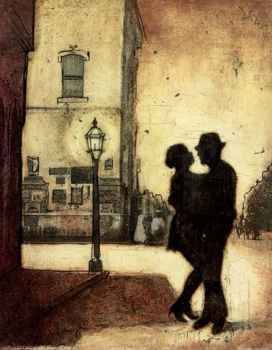
| Portuguese Passion | ||||||||||
The Tears Which Water The Flowers
Maxwell Chandler on Fado
For Chili...

You can say that jazz is one of, if not the only, purely American art form. While that is no longer true, and while in its infancy it needed the nurturing which it could only receive abroad due to segregation, that heady stew which drew from so many diverse sources could only have been cooked in what was then, the great melting pot.
While being an older music, Portugal’s Fado is made up of as many diverse ingredients. Aside from sharing jazz’s multi ingredient make up it also shares jazz’s emotional ability. The music manages to resonate an emotional landscape to its audience which is felt by each listener to be unique and deeply personal, while at the same time embracing all who are open to it.
To classify Fado as Portuguese “Blues” is to paint too simple a picture, to miss the point. Even the sorrow, base component for both is of different worlds. Nor should Fado or its cousins Tango, Duende and Flamenco be categorized as mere world/folk music.
Such terms too often now conjure up images of urban hipsters on a shopping spree at Borders.
Much like (Western) classical, one could spend their life familiarizing themselves with specific pieces, becoming a connoisseur in the same way one would with Wagner’s Ring Cycle. Indeed, there are complexities to rival any piece from the classical canons. There are established “rules” which gave way to sub genres and different “cults” of performers and compositional styles. Another way too, it is similar to the world of jazz, with its divisions of Bop, Cool, Free et al. Jazz, Fado, like all great art, steeped in tradition and ever in flux.
Like jazz and classical too, the established structure is often added to by each generation, new groups of players and composers adding reflections of their world view to renew the music and make it distinctly their own.
The cadence of the fadista’s voice can vary, although never according to the purist, but never the lyrical structure nor their intent.
Lyrically Fado songs are all about a sort of nostalgic longing. It is heartbreak, but also a thankfulness that something could have ever been a trigger for such powerful emotions.
Fado comes from the Latin word Fatum which means [an utterance , esp. a divine utterance]; hence [destiny, fate, the will of a god]; personif. Fata, [the Parcae or Fates]; [doom, fate, misfortune, ruin, calamity].
However, this definition gives only the smallest clue, a glimpse into what Fado has to offer, is about.
Like all music which has become deeply rooted in a culture’s identity, the exact origins of Fado remain unknown. It is known that Fado started appearing in the 1820’s. Within to be found, there are elements of African slave rhythms, Portuguese sailor music and some Moorish influences.
Initially there were but two types of Fado, originating from two specific areas in Lisbon. From Alfama and Mouraria came Fado which had a more salon/drawing room style. A chamber music using vernacular, beautiful but rigid in how the pieces were arranged and performed.
The other type came from Coimbra and incorporated Brazilian hall music popular with the heavy influx of Brazilian students who were appearing at this time.
While both styles proved to be equally popular, it would be another hundred years before any Fado music was put down on wax.
A key lyric ingredient for Fado is the feeling known as Saudade. It is the nostalgic aspect of Fado. It concerns people, heartache and remembrance as opposed to the other often used ingredient Banzo. Banzo is a nostalgia for one’s culture and homeland. Both are connected to the music through a beautiful sense of longing. An inner ache made into music in hopes that sharing this will perform some sort of release, but also showing a respect for the broken heart whose pain lets us know we are alive. Life so sharply felt is always worth living.
Lyrical content aside, another thing which was initially required for a piece of music to be considered Fado was a specific line up of instruments.
Sonically, the most prominent instrument is what’s known as The Portuguese Guitar. This is a twelve string instrument descended from a Moorish lute-like instrument and what is known as a Cistern. The tuning involves “watch key” tuning keys as opposed to modern day machine head pegs which are found on most guitars. When used for soloing, it posses a fuller sound than its relatives, the mandolin, lute or cistern.
This guitar was teamed up in the early days with a Spanish Guitar (classical style guitar) which the Portuguese called a Viola and a bottom end provided by a double bass.
Now one can find larger instrumental ensembles playing Fado on a far more diverse group of instruments both acoustic and electric. This early trio of instruments though, made sense in their portability and the perfect supportive counterpoint they provided to each other and the voice telling the tale.
For those not strict or “conservative” in their definition of what can be considered Fado, Fado music can now be heard, combining traditional instruments with more modern day technology to great effect (see the albums of Madredus and Mariza who combine an organic Euro-groove feeling with Fado’s power).
The first known “star” of Fado was a prostitute named Maria Severa. She was born the daughter of an innkeeper in 1820 in Lisbon. Her voice is unrecorded but there are many tales, all hard to confirm as hard fact which have become part of the public consciousness of Portugal.
Her legends all seem to contain many of the same elements which can be found in the powerful art form she helped birth.
Her first lover was shipped off to Africa during a flourish of Portuguese colonialism. She lamented his passing but soon was attached to a count. In his salons she shocked everyone by performing what would become Fado. Eventually the count was forced to separate himself from her. After this second major heart ache, in a fatal mood of Saudade she committed suicide in an orgy of the senses, drinking and eating (game bird) herself to death in one sitting.
The major lexicon began to form when poets, a natural fit for such subject matter, became involved in applying their pen. The early body of Fado work, the “standards” quickly numbered over two hundred.
The first and eternal modern day queen of Fado is Amalia Rodrigues. She had a long career and never seems to have taken an artistic mis-step, a rarity for any artist with such longevity.
Amalia was born July 23, 1920. Much like Louis Armstrong with his second birthday which was always give as July 4, Amelia always insisted she was born on July 1st.
In the timeless tradition of many great artists, she started working at an early age, hard, tedious jobs. At the age of nine she gave her first recital at her primary school. At this time too, she was selling fruit on the streets of Lisbon and doing embroidery work. During these formative years she could also be found working in a cake factory and in a souvenir shop with her mother and sister.
Her talent and drive were such that every year marked an important “first” for her. Too many to list, too many to keep this interesting. Two artistic touchstones however should be mentioned: 1935 marks the first time she performed, accompanied by a guitar during a benefit concert. 1945 sees Amalia make her first recording a 78 RPM single, done in Brazil.
During her career Amalia did extensive touring. She wracked up an impressive amount of appearances in movies, both at home and abroad. She seems to have fared better on the big screen than some of the other musical greats who tried, sometimes being the only good thing in a film.
In the 1950’s her power was such that she worked directly with many of her country’s greatest poets, some even writing lyrics specifically for her.
Amalia was often considered “the only” cultural ambassador to Portugal (literary giants Fernando Pessoa and Jose Sarmago might beg to differ). In her final years she was still making albums, the last one cut only a year before her death. In celebration of her long career there was a five hour television documentary made with her complete cooperation and featuring many candid conversations with the artist and some rare concert footage. This was eventually edited down for a DVD titled “The Art of Amalia”.
When Amalia died at the age of 79 the prime minister called for three days of national mourning. Her house in Lisbon is now a museum.
The best album for beginners, and the one I started off with is:
The Art of Amalia Rodrigues (Hemisphere). This is a compilation with pieces spanning the years 1952-1970. Unlike “best of” albums by jazz singers one does not get the feeling they are viewing only a small part of the picture, one aspect of the performer. Another contrast I have found from Jazz singers and even opera divas is that there is no division of artistic periods. There is none of that “I enjoyed this incarnation of her band when she had…” Nor is there such cherry picking of which recording labels receive preference from the enthusiasts. It all seems to have the same sonic feel and there is always an immediate connection with whom ever is accompanying her, year and record label aside.
The songs are of three different Fado styles although only the experienced Fado listener is going to notice any huge difference.
I am not a Fado conservative, but when I want my insides to vibrate in melancholy sympathy to the music, I prefer the traditional type of Fado. All the pieces on this album even the “evergreen” pieces have that.
Even though there are decades separating some of these performances. None give that feeling of coming at us from a distant, other time. It is unlike the earliest Edif Piaf recordings which sound as if they were only made to emerge from a Zinc tulip of a Victrola. Indeed, upon first listening, before reading the linear notes, I was surprised to find out how old some of the pieces were.
When I listen to the album it is always from start to finish. There is not one track without power. One favorite is Vou dar beber a dor (track 5 1968). The Portuguese Guitar does a bright, repetitive playful pattern. Her voice sounds sensual and playful always without the least affectation.
Jazz, Fado, you can tell people about it, but it is a road they must go down themselves. A trip which can last a life time and one which I highly recommend.
-Maxwell Chandler-
![]()
Maxwell will return soon with more adventures in sound.
| Click Here |
